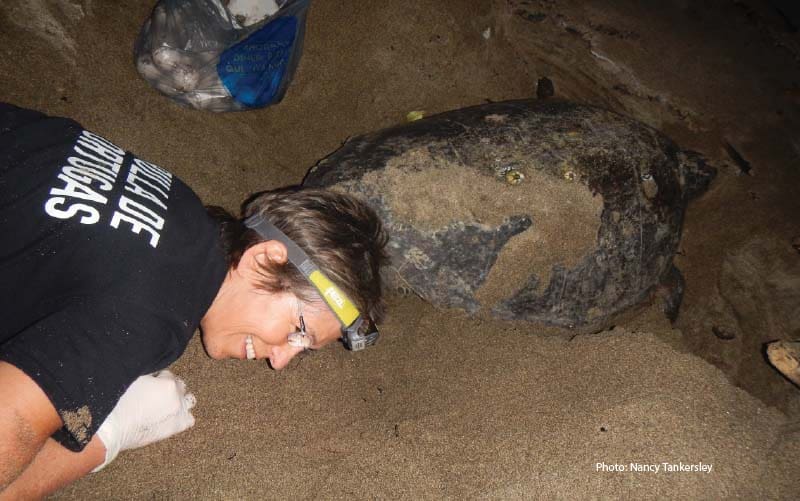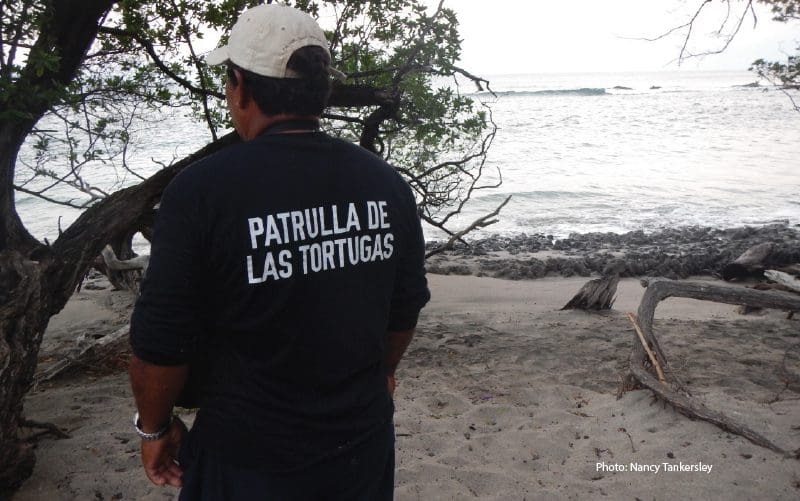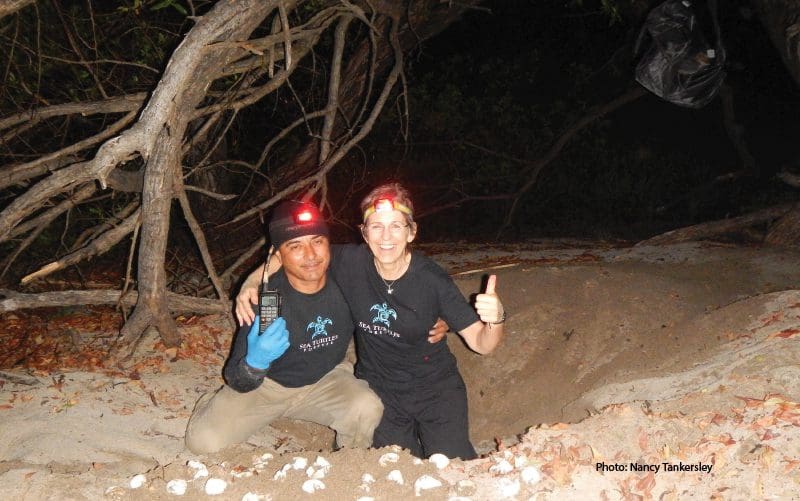
Turning Sea Turtle Poachers into Protectors
Photo above: Volunteer biologist Nancy Tankersley reaches into a fresh turtle nest to scoop out the eggs before poachers do. Photo: Nancy Tankersley
Poachers got to the nest in Playa Lagartillo first. Where there should have been dozens of sea turtle eggs buried in the beach, there was just a hole. The eggs had been stolen by human hands, to be sold on the black market as aphrodisiacs (a myth). Carlos came across the raided nest in the middle of the night, the time when turtles often lay their eggs. He patrols the beach south of Tamarindo for the conservation group Sea Turtles Forever (STF). Besides contributing to research and education, night after night STF patrollers race poachers in order to relocate the eggs in secret locations away from the turtle’s tell-tale tracks. This time, Carlos lost the race. But STF has many more success stories.
Every egg saved is another chance
that a sea turtle will hatch, reproduce
and help the population recover.
Sea Turtles Forever (STF) saves 5,000 to 12,000 eggs every year. Every egg saved is another chance that a sea turtle will hatch, reproduce and help the population recover. STF pays local residents, even some former poachers, more money than they would make selling the eggs. These patrollers scan the Guanacaste beaches of Los Pargos/Playa Negra, where turtle populations have been decimated by illegal egg takes, fishing nets and coastal development.

STF patrol officer scans the beaches around Los Pargos/Playa Negra for beaching turtles and poachers.
The organization’s mission is a passion for Nancy Tankersley, who returns to Los Pargos every January and February to serve as volunteer biologist for STF — a far cry from her home in subarctic Alaska. So how did Tankersley become a sea turtle conservationist in Costa Rica? You’d have to go back 30 years, to a starlit night on Playa Grande, just north of Tamarindo, during a two-week natural history tour.
“Our guide found a leatherback on the beach digging a nest,” she recalled. “We witnessed the whole nesting event, then encountered a nest of baby leatherbacks just hatching. The whole night was magical and unforgettable. So, when my kids went off to college, I started volunteering for sea turtle projects and found this one in 2012.”
Since then, Tankersley has been instrumental in saving thousands of turtle eggs on Pargos beaches.
“When Marc and Rachel Ward founded STF about 20 years ago, almost 100 percent of the eggs were taken illegally,” she said. “With our patrollers on the beach every night during the nesting season and growing community support, poaching has dropped to less than 10 percent.”
Spreading awareness
Sea Turtles Forever spreads its conservation message in any way it can. Tankersley welcomes tourists to join her night patrols. Patrollers visit local schools to educate youth. STF raises money through donations and grants. $100 US lets donors adopt and name a tagged sea turtle. And every bit helps to sustain the depressed populations.
“There was a time when 300 green sea turtles would nest per night around Los Pargos, but now we see 0-2 nests per night,” Tankersley noted.

STF Lead Patroller William Zuniga and volunteer biologist Nancy Tankersley celebrate a successful nest relocation.
Grim numbers, but there’s hope. After losing the first nest to poachers at Playa Lagartillo, the next night Carlos was on beach patrol duty, he saw men hovering around another turtle. He went to chase the thieves off, only to find the young men had actually protected the turtle’s eggs from poachers while it was laying them. And it was a special turtle — one that STF had tagged 10 years ago.
Carlos took all the 52 ping-pong-ball-sized eggs (the average nest contains 60) and moved them to another beach location. There he dug a hole, placed the eggs inside and covered them up with no evidence to suggest anything was underneath. In about 55 days the hatchlings will emerge and scramble to the ocean, oblivious to the close call they had. With this new generation of turtles comes a new generation of protectors instead of poachers.
How to Help Sea Turtles
We can all do our part! These suggestions come from Nancy Tankersley, volunteer biologist at Sea Turtles Forever (STF): www.seaturtlesforever.org
-
- Don’t eat turtle eggs at local bars and restaurants. Illegal eggs are often sold as legal or “certificados” from Ostional, but many are not legal.
- Don’t drive on soft beach sand. It makes it hard for turtles to dig nests and almost impossible for baby turtles to dig out after hatching underneath.
- Minimize the use of white lights on the beach at night during nesting/hatching season (mainly October to May on Costa Rica’s Pacific coast). Use red lights on headlamps or cover flashlights with red cellophane.
- Pick up litter on the beach, especially plastic. It fragments and absorbs toxic compounds in the ocean, which can be ingested by turtles and other marine life.
- Don’t cut or burn wood from beach trees. They provide an important turtle nesting habitat and keep the sand moist for nests. Campfires can overheat nests underneath the sand (mostly from October to May).
Donate to www.seaturtlesforever.org/donate or another ocean conservation group.

